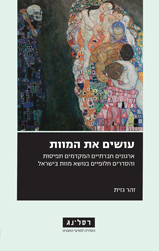
Following the tragic passing of my father, I spent a lot of time thinking about mourning rituals, and particularly about the invaluable work of Menuha Nekhona (“A Righteous Rest”), the all-volunteer organization that runs the secular-civil cemetery in my parents’ town. I was so impressed with them that I started drafting a book proposal about secular burials in Israel, but a few days later found out that someone has already written a book about alternatives to religiously sanctioned deaths: Zohar Gazit’s A Struggle to the Death (Tel Aviv: Resling, 2016) (Hebrew.) The original title, “Osim et HaMavet” (“making death”) is a double entendre: it’s a figure of speech meaning “haranguing someone” and also, in this context, implies the creative remaking of a hegemonic ritual in a way that fits the needs and concerns of deeply underserved populations.
Gazit’s book, which is based on his doctoral dissertation, examines three alternative death initiatives: in addition to Menuha Nekhona, he looks at Path to Life, an organization devoted to the healing and welfare of family survivors of suicide and to the destigmatizing of these deaths, and at Lilach, an organization promoting death with dignity (passive euthanasia) for terminally ill patients. Gazit’s theoretical framework heavily relies on Bordieu’s “field” concept (what sociological work doesn’t?) and shows the complicated relationship that each of these organizations has with the death “field.” All three of these organizations struggle against the hegemonic death rituals and perceptions in Israeli society: the religious concept of suicide (and any other actively chosen form of death, including some forms of euthanasia) as defying halakhic rules; the aggressive and greedy religious monopoly on burials in Israel, run by Orthodox Hevre Kadisha organizations who perform alienated, antiquated rituals, discriminate in plot allocations, and humiliate the dead and their loved ones; and the Israeli hierarchy of death, which glorifies military casualties and features a constant contest among other groups about their relative prestige, access to services, and differential stigma.
Gazit’s analysis is incisive and sensitive. His ethnography (participation in meetings and rituals, plenty of interviews, clever media analysis) shows internal conflicts and contradictions within the organizations he examines. What they want to highlight, and who they want to associate themselves with, is a delicate and carefully strategic dance of courting legitimacy and support. For example, Path to Life activists fiercely oppose efforts to downgrade the status of soldiers who committed suicide beneath that of supposedly legitimate military casualties; at the same time, they assiduously avoid even the semblance of supporting suicide as a legitimate option. They also contest professional opinions that discourage open talk of suicide as potential encouragement, arguing that open conversation can invite attention, help, and saving lives. Similarly, Lilach activists try to disengage from suicide organizations and stick to passive euthanasia, so as not to invite displeasure. And Menuha Nekhona have faced a complicated relationship with the very few people in Israel who sought cremation, an option associated with deeply negative stigma in Israel due to the legacy of the holocaust; at the same time, they’ve had to partner sometimes with Hevre Kadisha for burial services, among other surprising disclosures in procuring coffins: traditional Jewish burials are in shrouds, with no coffin, but bodies flown in from abroad arrive in coffins and Hevre Kadisha sell these to Menuha Nekhona.
Gazit’s book is full of fascinating information for anyone interested in social movements, sociology of religion, political theory, and constitutional law. I learned a lot. There is plenty I’m interested in that I didn’t find in the book (such as the negotiations of individual burial styles, headstones, and maintenance), but there’s only so much one can include in one work. My only quibble–a minor one, and by no means limited to Gazit’s book–is that he repeatedly relies on the terms “good death” and “bad death” for, respectively, the hegemonically sanctioned death and the alternatives. I know these are both well-established sociological terms of art and Gazit is correctly using them. But terms of art in sociological theory can sometimes sound jargony and, in this case, given that these organizations fight deep injustices, come off a bit precious and more than a bit jarring in their aesthetic and moral removal. I would have preferred “hegemonic” and “alternative.”
This minor issue aside, Gazit’s book is an important and worthy addition to other texts investigating national-religious hegemonies in Israel and those who try to contest them, such as Daphne Barak-Erez’s Outlawed Pigs and Michal Kravel-Tovi’s When the State Winks. I’ll end with my favorite passage (in my own translation from Hebrew):
All three organizations have emblazoned death on their flag, but they carry a message of life. Better, safer, richer, more mindful life, achieved through dealing with the “bad death.” From an event that happens to us, death is shaped as an event that we are active in. Passive social isolation, leaving decisionmaking to the medical establishment and later to Hevre Kadisha with no input from the individual and their loved ones, are replaced by decisions, choices, and action. Addressing “bad death” is framed as an empowering resource in the activists’ lives–an expression of courage, principled stance, and a struggle against injustice.




No comment yet, add your voice below!